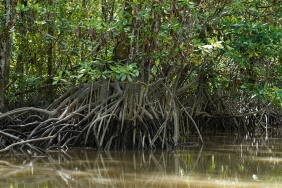OF 120 SUMATRAN ELEPHANTS KILLED IN RIAU SINCE 2004, ONLY ONE CASE BROUGHT TO COURT
Pekanbaru - The skeletons of seven Sumatran elephants (Elephas maximus sumatranus) were found on February 21, 2014 in the area of PT RAPP Sector Baserah, Lubuk Kembang Bunga Village, Ukui Sub-district, Pelalawan Regency - which borders Tesso Nilo National Park, Riau. The seven skeletons consisted of one female mother elephant, five male calves and one adult male elephant. When found, all six pairs of tusks were missing, presumably removed using a sharp object. The removal of the tusks indicates that the ivory taker is someone who understands the trade in wildlife body parts.
The seven elephant skeletons found in the same location are suspected to have died from eating food containing poison. In some cases of elephant poisoning, the poisonous material is usually mixed with soap or fruit such as jackfruit and pineapple, which are favored by elephants. Pesticides containing toxic ingredients are widely misused by certain parties to poison elephants. WWF's search results in several locations around Tesso Nilo found that pesticides containing poison are very easy to obtain. "The repeated and systematic deaths of elephants like this show the weak law enforcement on protected animals in Riau. Law enforcement officials must immediately investigate this case and all cases of elephant deaths, so as to create a deterrent effect for the perpetrators," said Anwar Purwoto, Program Director of Sumatra and Kalimantan WWF-Indonesia.
According to WWF-Indonesia data, since 2004 at least 128 elephants have died in Riau. Sadly, only one case was successfully brought to the green table, namely the case of ivory poaching in Mahato- Rokan Hulu Regency in 2005. In the last three years, none of the 38 dead elephants in Riau have been brought to justice even though some evidence has been found in the field, such as the presence of poison proven through laboratory tests. In the Tesso Nilo Forest Block alone in the last two years (2012-2013), 26 elephants were recorded dead, most of which were poisoned.
"Special criminal cases for wildlife that occur in Riau are indicated not only to be carried out on the basis of land conflicts in the Tesso Nilo National Park area, but also have become extraordinary cases because they are carried out repeatedly and systematically, which allegedly involve national and international ivory trade networks," said Suhandri, Regional Leader Sumatra WWF Indonesia. "The Tesso Nilo National Park and Riau Natural Resources Conservation Center should coordinate with the Riau Police to uncover and enforce the law on elephant deaths in Riau, so that cases like this are not repeated," Suhandri added.
To minimize elephant deaths in Tesso Nilo WWF-Indonesia encourages authorities to complete the process of handling overlapping use of areas in TNTN. WWF-Indonesia also requests that concessionaires around TNTN improve area management and support efforts to resolve cases of elephant deaths that occur in their production areas.
WWF-Indonesia's research shows that currently the population of Sumatran elephants is increasingly alarming, in one generation (25 years), Sumatran elephants have lost about 70% of their habitat, and their population has shrunk by more than half.
Editor's Note:
- Map of dead elephant locations can be downloaded at http://bit.ly/MnqTuI
- To reduce elephant conflicts with humans, WWF-Indonesia together with the Ministry of Forestry has mitigated elephant conflicts by establishing the Flying Squad, a group of trained elephants to drive wild elephants out of the TNTN area, which is placed in Lubuk Kembang Bunga Village, Ukui District, Pelalawan, which is one of the villages directly adjacent to TNTN. With the operation of the Flying Squad, about 70% of the loss of the surrounding community compared to before the operation was successfully suppressed.
- In addition to direct efforts to mitigate elephant conflicts such as with the Flying Squad, government efforts are needed to strictly control the trade in toxic materials that can lead to elephant deaths. Thoroughly investigating the existence of missing ivory will also lead to the existence of national and international trade networks behind the death of Sumatran elephants.
For more information, please contact:
- Suhandri, Program Koordinator Sumatera-WWF-Indonesia, suhandri@wwf.or.id, +628127522745
- Anwar Purwoto, Program Director Sumatra and Kalimantan apurwoto@wwf.or.id, +628121108654





